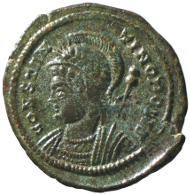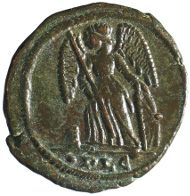by Björn Schöpe
October 23, 2014 – The British PAS (Portable Antiquities Scheme) looks back on 14 successful years. Since 1997 private people, metal-detectorists and amateur archaeologists, can report their findings with the scheme in order to make them accessible to researchers and museums. Recently PAS has published its latest annual report which shines with a round number: the one millionth coin!
The millionth object recorded on the PAS database: a copper alloy coin struck by Constantine I to celebrate his new city of Constantinople (Istanbul), struck at Lyon in AD 332, found in the Seaton Hoard (Devon). The obverse shows the personification of Constantinopolis. The reverse shows Victory on a prow. © The Trustees of the British Museum.
The jubilee coin itself is by no means a spectacular item. It is a Constantinian bronze coin from AD 332. However, the coin comes from a large coin hoard comprising some 22,000 coins, testifying vividly the enormous success of the scheme.
Since 1997 numerous hoards and treasures (findings which are considered of particular importance) have been found besides smaller discoveries. Neil MacGregor, director of the British Museum, which coordinates the scheme in major part, comments proudly: ‘The success of the PAS and finds.org.uk cannot be overestimated in terms of our understanding of our past. The sheer variety and diversity of finds registered over the scheme’s 17-year history is extraordinary, and the one millionth find is a truly exciting milestone.’
The Seaton Hoard after light conservation. © The Trustees of the British Museum.
Indeed there are three rulers we know only through findings recorded by the PAS, namely an Iron age chieftain, a Roman emperor, and a Viking ruler. Here we must bring up a very controversial aspect: archaeologists in particular often argue against metal detectors that their acting destroys find contexts. The coins therefore could not lead to any further historical knowledge. The PAS statistics, though, give a different idea. Just browse through the impressive list of findings which have been analysed since. Taking a closer look at the statistics the numbers reveal also that the finders have become much more diligent. At the beginning, in 1997, only 56 percent of all findings had a 6-figure NGR (National Grid Reference), that is to say good findspot information. Today the figure has raised to 99 percent! As it seems, the scheme contributes to make hobby archaeologists support academic research and not interfere with it.
The project aims very much at public presence: officers inspire children in schools, they visit detectorist clubs, and appear on the radio. The TV series Treasure Hunter enjoyed a second season; the audience accompanied the finders of objects housed today in the British Museum on their original search for the items.
In 2007 some 160,000 persons visited the PAS website, in 2013 visitors had raised to more than half a million!
The scheme has a very nice and informative website.
Those who wish more detailed information should consult the annual report 2013.
A recent blog article of the British Museum gives a thorough overwiew.







